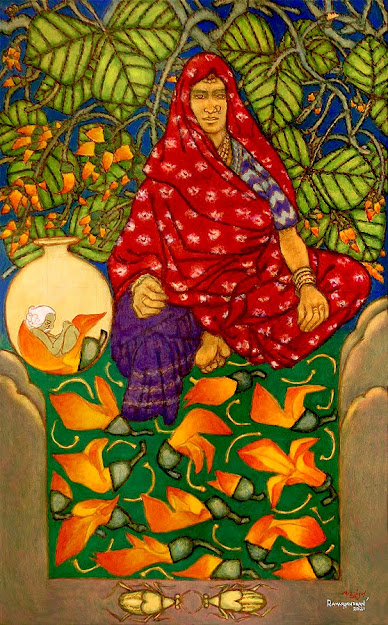 |
| The latest paintings of A Ramachandran |
Half a century has passed since the artist has been directly familiar with the Bhil ways of life. The tribal community of Rajasthan has featured fairly regularly in Ramachandran’s artworks from the mid-1980s. The latest in the series, though, stands out for their thematic difference—this time owing to an uncanny link the rustic females bear with the haloed eight heroines from an ancient Sanskrit treatise.
Called ‘Subaltern Ashtanayikas’, the set of paintings is currently on display in the national capital. Paired with his latest images in the famed ‘Lotus Pond’ series, the images totalling 13 made it to two venues of the city by Vadehra Art Gallery (VAG).
The Ashtanayikas, as cited by Bharata Muni in his two-millennium-old work on dramaturgy, portray eight mental states of women in love. The circumstances range from coquettish to distressed to deceived, but overall the concept holds an exalted status in classical paintings, sculpture, dance and literature. “My Nayikas, here, are a far cry from the conventional sensibility. You can even say mine are a pun on the original,” shrugs Padma Bhushan Ramachandran, who lives east of the Yamuna in Delhi.“After all, love is not a privilege of just the pretty. Any kind of man and woman can get attracted to each other.”
 |
| The latest paintings of A Ramachandran |
Ramachandran’s Ashtanayikas are today part of Subaltern Nayikas and Lotus Pondbeing held at VAG’s Modern Gallery in Defence Colony. The month-longshow is to end on December 12, while arelated 17-day exhibition at Shridharani Gallery of Triveni Kala Sangam on Tansen Marg (Mandi House) concluded on November 30.
All the eight heroines were painted during the lockdown months that ensued the outbreak of Covid-19. The worldwide pandemic showed its fierce face in Delhi as well, prompting Ramachandran to remain indoors since February last year. That is when the artist decided to experiment with his Bhil tribal women he had sketched during earlier visits to villages around Udaipur in the southern belt of the desert state.
“The attic of my studio has hundreds of such drawings I had done with the Bhil women as the subject. Of late, under virtual house arrest owing to the massive spread of coronavirus, I decided to work on a select few of them,” reveals the Kerala-born artist who did his higher studies at West Bengal’s famed Santiniketan. “Eventually the theme of Ashtanayikas dawned upon me. I chose to work on eight sketches of the Bhil women I had met in the last decade.”
Ramachandran attributes the idea to his “Malayali sense of humour” that tends to be sceptical about idealism. Agrees art historian Rupika Chawla, noting that black humour and irony are intrinsic to Ramachandran’s artistry. “It is typical of his creative programming,” she says. “The artist typically goes for playful use of visual expression.”
The 86-year-old artist says the Bhil women are an especially apt choice to be the Ashtanayikas for his painting, considering theirs is one of India’s oldest communities. “They come as an ancient appearance…also a dying culture.”
Ramachandran, who is a native of Attingal near Thiruvananthapuram, did his Masters in Malayalam literature before leaving for West Bengal in 1957 to enroll as a student at Rabindranath Tagore’s famed institution. He has been a Delhiite since the mid-1960s, having taught at JamiaMilliaIslamia. He is also a winner of prestigious honours such as the KalidasSamman and the Raja Ravi Varma Puraskaram.




